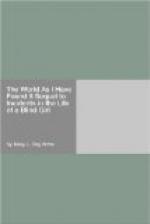The most interesting things seen in an Institution for the Blind are the apparatus for teaching geography, philosophy and physiology. For geography miniature continents, states, hemispheres, etc., are used, in which, the political divisions, the physical conformation and characteristics, the rivers, lakes, seas, etc., etc., are reproduced as nearly as possible. The boundaries are described by rows of raised dots, the capital cities by studs of peculiar shape, the larger cities by studs different in size or shape, the rivers by grooves in the surface, deserts by spaces being sanded on the surface, the lakes, seas, etc., by depressions, and the islands by spots elevated above the seas’ surface. Mountain ranges are shown by raised models or miniature mountains, and that volcanoes may be fully understood, separate models of these and of other remarkable formations are used, that the student, by a thorough manual examination, may get a correct knowledge of them. In nearly every school I have visited there were maps, the sub-divisions of which consisted of movable blocks. Supported like a table, these maps would be studied by the pupils taking out the blocks and returning them to their places as they learned their names, etc. It is no uncommon thing to see a pupil throw these blocks into a confused heap, mix them all up, and, then picking them up one by one, put each in its place with as much accuracy as the most accomplished pianist will strike each key in a simple march or polka.
The philosophical apparatus consists of miniature machinery: the spring, the simple and compound lever, the wheel, the cog, the cam, etc., even to the miniature engine are brought into use, and the pupils examine them by themselves, and in their various applications and relations to each other. In teaching those who never could see great difficulty is experienced in conveying the nature and properties of gases, vapors, etc., but with those who have any recollection of what they have seen the task is comparatively easy.
Where the apparatus is possessed the teaching of physiology and natural history are comparatively easy, the pupil handling and examining skeletons, skulls and models of the various parts of the human system, learning their various offices, etc., but many schools do not possess them, while others have fine collections including busts of eminent or notorious personages, zoological collections, plaster models, etc., by which the loss of sight is largely compensated for.
Music is taught by raised notes until the rudiments are mastered. It forms a great part of the course in all the institutions, and is cultivated with great assiduity. When the rudiments have been mastered and the pupil is familiar with the instrument, the music is read to them, the notes indicated by names and value, and they memorize the music. So thoroughly do many of the blind master the art that several are now, within my knowledge, successful teachers of the art to large numbers of seeing pupils. On the other hand much valuable time is wasted in the effort to teach music to those who have no talent for it, and whose time might be more profitably employed in the pursuit of other studies.




